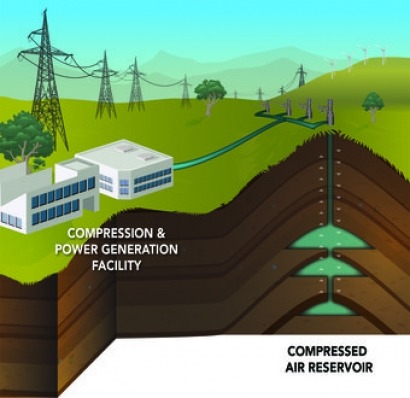
The Pacific Northwest National Laboratory (PNNL) based at Richland in Washington State, USA, has released a new comprehensive report, compiled in association with the Bonneville Power Association (BPA), which reveals that enough wind energy to power about 85,000 homes could be stored underground for later use. The study identifies two unique methods for achieving this and recommends at least two locations in eastern Washington State where the technique could be put into practice.
The techniques identified by the laboratory, which is part of the US Department of Energy (DOE), involve the use of compressed air in plants that could switch almost instantly between energy storage and energy generation, thereby providing greater flexibility in order to balance the region’s highly variable wind energy generation throughout the day.
“With Renewable Portfolio Standards requiring states to have as much as 20 or 30 percent of their electricity come from variable sources such as wind and the sun, compressed air energy storage plants can play a valuable role in helping manage and integrate renewable power onto the Northwest's electric grid” said Steve Knudsen, who managed the study for the BPA.
Compressed air energy storage plants work under the same basic premise in that, when power is abundant, it’s drawn from the electric grid and used to power a large air compressor. This pushes pressurized air into an underground geologic storage structure where it is retained until needed. The stored air is then released back up to the surface where it is heated and rushed through turbines in order to generate the electricity. In this way, compressed air energy storage plants can re-generate as much as 80 percent of the electricity they take in.
Only two such plants exist at present, one of them in Alabama and the other in Germany. They both use man-made salt caverns to store excess electricity. The PNNL-BPA study has however identified a different approach which uses natural, porous rock reservoirs deep underground.
Around 13 percent, nearly 8,600MW, of the North West’s power supply comes from wind and this prompted the two organisations to investigate whether the compressed air approach could be used in the region. Two promising locations were identified, the Columbia Hills site is just north of Boardman, Oregon, on the Washington side of the Columbia River, while the Yakima Minerals site is about ten miles north of Selah, Washington, in an area known as the Yakima Canyon. While the Columbia Hills site could access a nearby natural gas pipeline in order to use a conventional compressed air energy facility the Yakima site would have to use geothermal energy in order to power a chiller that would cool the facility’s air compressors, thereby making them more efficient. Geothermal energy would also be used to reheat the air as it returns to the surface.
“Combining geothermal energy with compressed air energy storage is a creative concept that was developed to tackle engineering issues at the Yakima Minerals Site” said PNNL Laboratory Fellow and project leader Pete McGrail. “Our hybrid facility concept significantly expands geothermal energy beyond its traditional use as a renewable baseload power generation technology.”
The respective facilities could particularly help the region during the spring when there is sometimes more wind and hydroelectric power than the region can absorb. Compressed air energy storage plants could help the North West make the most of its excess clean energy generation.
Further information:

